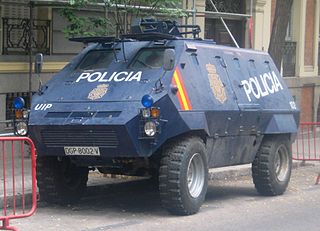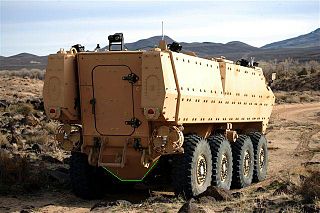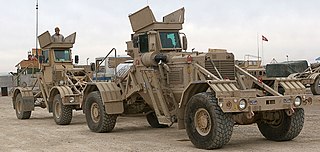
The Casspir is a Mine-resistant ambush protected vehicle that has been in use in South Africa since the 1980s. It is a four-wheeled, four-wheel drive vehicle, used for transport of troops. It can hold a crew of two, plus 12 additional soldiers and associated equipment. The Casspir was unique in design when launched, providing for passive mine defence. The main armoured steel body of the vehicle is raised high above the ground, so when a mine is detonated, the explosion is less likely to damage the crew compartment and kill the occupants. The cross-section of the hull is V-shaped, directing the force of the explosion outwards, further protecting the occupants.

The Mamba is a South African armoured personnel carrier designed for internal security purposes. It was developed during the late 1980s to replace the Buffel in service with the South African military and security forces. The first models were built on a 4X2 Toyota Dyna chassis, which was subsequently replaced in production around 1994 by a more reliable Unimog chassis. All marks of the Mamba were designed to be mine-resistant and blastproof.

The RG-31 Nyala is a 4×4 multi-purpose mine-resistant ambush protected infantry mobility vehicle manufactured in South Africa by Land Systems OMC, located in Benoni, South Africa and in Turkey by FNSS Defence Systems. It is based on the Mamba APC of TFM Industries.

The Buffel is an infantry mobility vehicle used by the South African Defence Force during the South African Border War. The Buffel was also used as an armoured fighting vehicle and proved itself in this role. It replaced the older Bedford RL-based Hippo APC and itself was replaced by the Mamba from 1995 in South Africa, but remains in use elsewhere, notably Sri Lanka.

The RG-33 is a mine-resistant light armored vehicle initially designed by BAE Systems Land Systems South Africa, a South African subsidiary of BAE Systems. BAE Systems in the US extensively modified it with additional protection, new powertrain, and suspension systems. It was built in a number of locations including York, Pennsylvania. It was one of several vehicles being fielded by the US Armed Forces in Iraq under the MRAP program.

An infantry mobility vehicle (IMV) is a wheeled armored personnel carrier (APC) serving as a military patrol, reconnaissance or security vehicle. Examples include the ATF Dingo, Iveco LMV, Oshkosh M-ATV, AMZ Dzik, AMZ Tur, Mungo ESK, and Bushmaster IMV. This term also applies to those vehicles fielded as part of the MRAP program.

The Thyssen Henschel UR-416 is a German armoured personnel carrier, first introduced in 1969 and based on the body of the Mercedes-Benz Unimog light truck.

The Rhodesian Security Forces were the military and security forces of the Rhodesian government. The Rhodesian Security Forces consisted of a ground force, the Rhodesian Air Force, the British South Africa Police, and various personnel affiliated to the Rhodesian Ministry of Internal Affairs. Despite the impact of economic and diplomatic sanctions, Rhodesia was able to develop and maintain a potent and professional military capability.

The V-hull is a type of vehicle armor design used on wheeled armored personnel carriers (APCs), infantry mobility vehicles, infantry fighting vehicles (IFVs) and MRAPs. The design originated in the 1970s with vehicles such as the iconic Casspir used extensively during the South African Border War, Leopard security vehicle used in the Rhodesian Bush War and South African armored vehicle company Land Systems OMCs and Buffels.

The Husky VMMD is a configurable counter-IED MRAP vehicle, developed by South African-based DCD Protected Mobility and American C-IED company Critical Solutions International. Designed for use in route clearance and de-mining operations, the Husky is equipped with technologies to help detect explosives and minimise blast damage.

The Pookie MRAP vehicle was created to deal with the constant mining of roadways during the Rhodesian Bush War.
The Gazelle FRV or Fast Reconnaissance Vehicle is a 4×4 infantry fighting vehicle (IFV) built for reconnaissance on the chassis of the Mercedes-Benz Unimog light truck developed by Zimbabwe in the early 1980s.

The Mine Protected Combat Vehicle – MPCV was a Rhodesian 4×4 Infantry fighting vehicle (IFV), first introduced in 1979 and based on the body of the Mercedes-Benz Unimog light truck. It remains in use with the Zimbabwe National Army.
The Bullet Troop-Carrying Vehicle (TCV) is a light 4x4 infantry fighting vehicle (IFV) developed by Rhodesia in the late 1970s based on the body of the Mercedes-Benz Unimog light truck.
The Crocodile Armoured Personnel Carrier or "Croc" is a Rhodesian armoured personnel carrier first introduced in 1977 and based on Japanese commercial trucks' chassis. It remains in use with the Zimbabwe National Army (ZNA).
The MAP75 Armoured Personnel Carrier is a Rhodesian 4x4 heavy troop-carrying vehicle (TCV) first introduced in 1978 based on a Mercedes-Benz truck chassis. It remains in use with the Zimbabwe National Army.
The MAP45 Armoured Personnel Carrier is a Rhodesian/Zimbabwean 4x4d heavy troop-carrying vehicle (TCV) first introduced in 1978 based on a Mercedes-Benz truck chassis. It remains in use with the Zimbabwe National Army.

The Hippo is a South African armoured personnel carrier. Specially designed to be mine resistant, it can carry ten infantrymen and a crew of two. The vehicle's remote-operated turret mounts dual 7.62mm machine guns, but like other improvised fighting vehicles, it is only lightly protected against ballistic threats.

The Wer'wolf MK2 is a Namibian designed and built military vehicle that offers protection against small arms fire and land mines. The vehicle uses a MAN chassis, axles and engine. The Wer'Wolf MK2 is a modular vehicle. It is built with a crew compartment that seats three people plus a driver and a rear flatbed configuration. The flat bed configuration allows for different modules to be fitted. It is suited for rough terrain, in APC configuration the Wer'Wolf MK2 can carry up to 10 passengers plus the driver. Designed and built in 1998 it was the first Mine Protected Vehicle manufactured by Windhoeker Maschinenfabrik after it was bought by Government of Namibia.
Zimbabwe Defence Industries (Pty) Ltd (ZDI) is a state-owned Zimbabwean arms manufacturing and procurement company headquartered in Harare, with a primary focus on sporting and military ammunition. In the past it has also manufactured mortar rounds, land mines, and light armoured fighting vehicles such as the Gazelle FRV. During the late 1990s, ZDI was involved in brokering major arms deals between China and other African governments such as the Republic of the Congo. The subsequent economic depression in Zimbabwe, as well as the collapse of the Zimbabwean dollar against major world currencies, have forced ZDI to limit its activity to exporting second-hand equipment from the Zimbabwe Defence Forces.
















